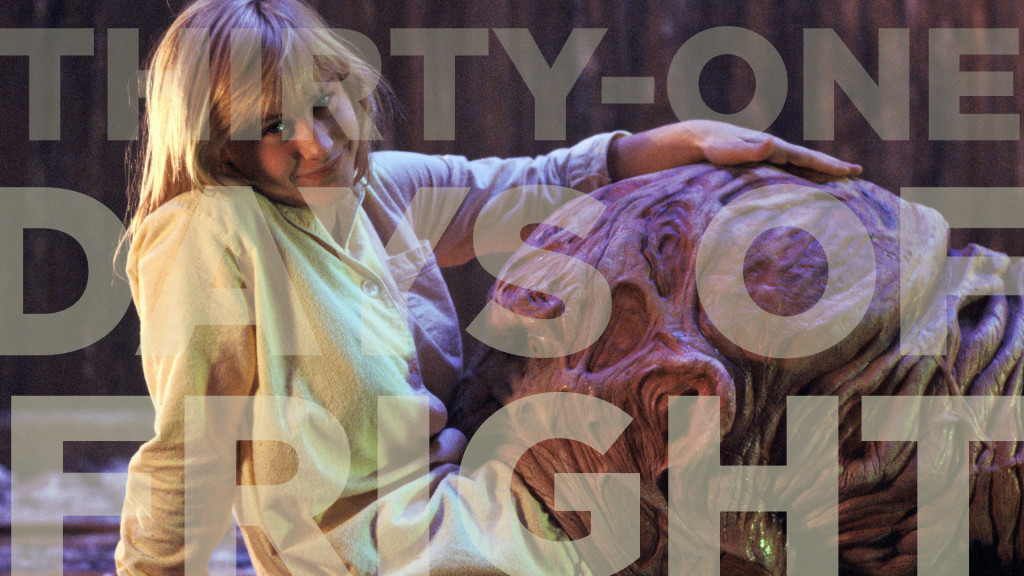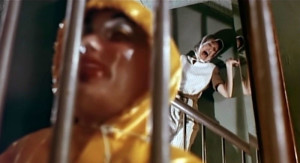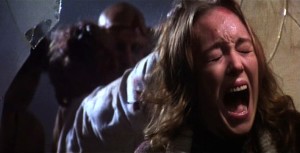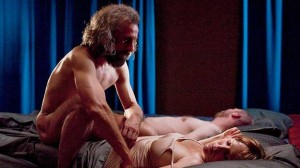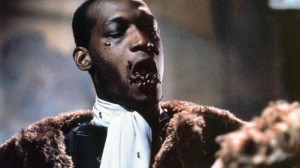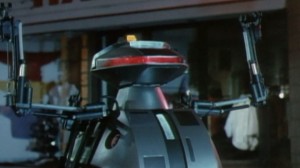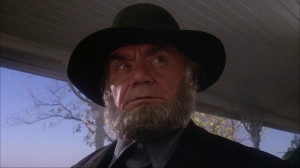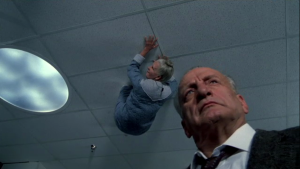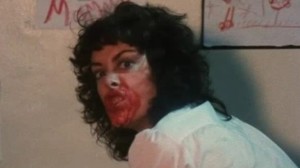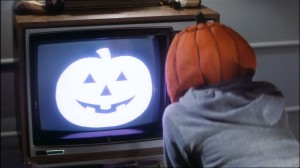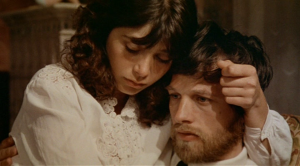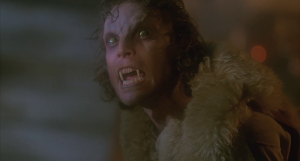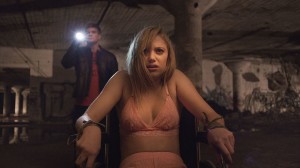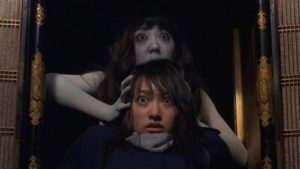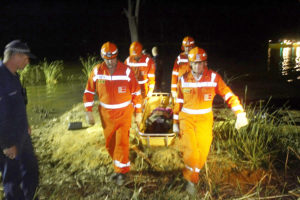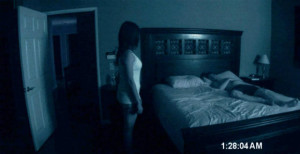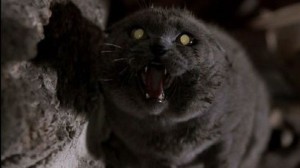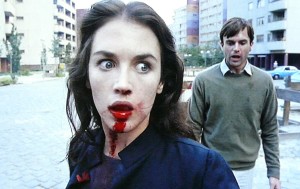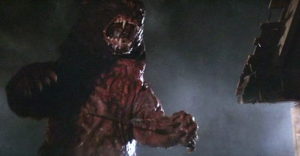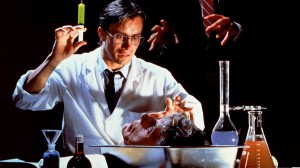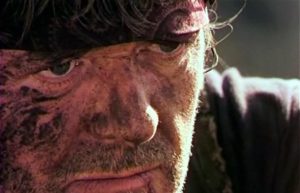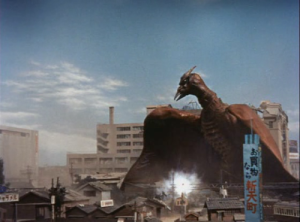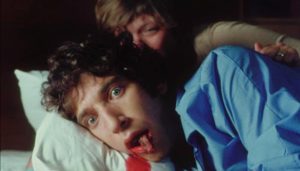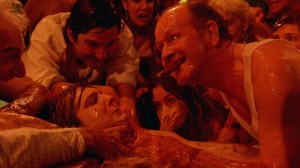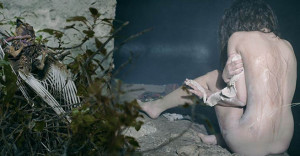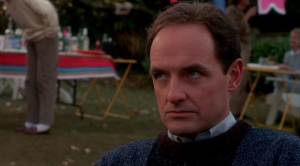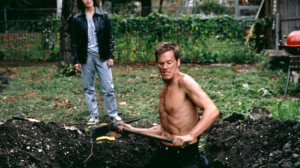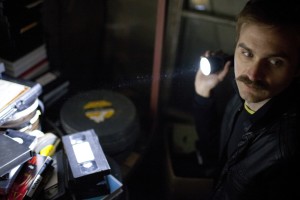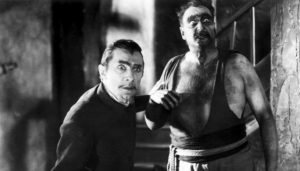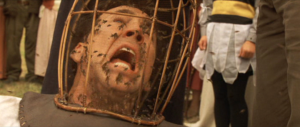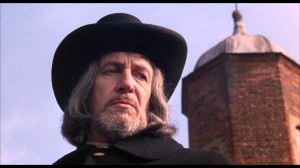
Katahdin, about to commit a grizzly … uh, *grisly* murder.
This January, in support of the Toronto Rape Crisis Centre / Multicultural Women Against Rape, friends and family have raised over $1,000, which means I have to watch and write about thirty-one horror movies. I’ll watch (on average) one movie a night, many of them requested by donors, after which I’ll write some things about said movies on this website. Be forewarned that all such write-ups will contain spoilers! Last night’s film was Prophecy, directed by John Frankenheimer (The French Connection, Seconds, The Manchurian Candidate). I donated $25 to my own fundraiser so I could secure a spot for this mutant bear movie to compare it to the bear mauling flick du jour, The Revenant. Well, that and to watch this classic scene – shown to me by my former coworker, the excellent writer Kevin Hardcastle (Debris) – in context. A couple of questionable movie enthusiasts – friends Meg and Phil – came over to watch Prophecy – not to be confused with the Christopher Walken alien movie of the same name – with me as part of a semi-regular series of screenings I hold in my apartment, Not-Good Tuesdays. Prophecy was rented – like most of these movies – from Queen Video.
What happens:
Prophecy opens in a dense pine forest. A search-and-rescue team, visible only by their head lamps, races through the trees. Their bloodhounds lead the hunt, but one dog becomes so eager he runs straight off a cliff. The rescuer struggles to hold the hound up by his leash. Something starts pulling on the other end, and the other rescuers help him to pull the dog to safety, but when they do, the collar is empty. “I didn’t hear him hit,” marvels one. Two of the rescuers – Jim and Bill – rappel down the cliff face to see what happened to the dog. The lone rescuer left at the top of the cliff hears them scream, so he rappels after them. But he gets into a bit of a mishap and lands square on his back onto a rocky outcropping. Unable to move, he turns his head and sees his dead compatriots. A roar breaks through the silence and the man screams. When we next see him (and the other two rescuers), they lie bleeding at the bottom of the cliff face, their helmets stained with blood. A classical score plays over the tableau.
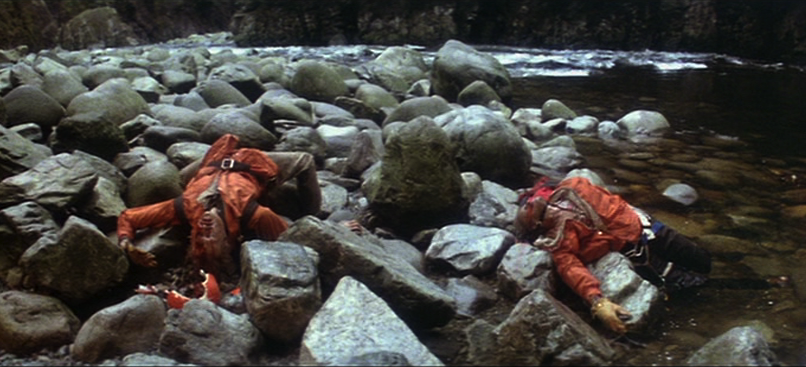
Search-and-rescue workers demonstrating the improper way to work on your tan.
However, there’s a very good explanation for the classical music: it’s being played by one of our protagonists, Maggie (Talia Shire, fresh from her work on the Rocky movies), a cellist with the orchestra. Following a rehearsal, a fellow cellist asks Maggie if she’s told her husband yet that she’s pregnant. Maggie has not, as she knows her husband, who is what conservative types might call a Social Justice Warrior, doesn’t want to bring another child into the world. (That old story.) Her friend worries that Maggie will be pressured into an abortion. That very do-gooder husband, Rob Verne (Robert Foxworth), is across town, visiting an inner-city slum. A public-health official, he makes a house call to a woman whose child displays a strange rash. She complained that it was from the rats in the apartment, but her landlord insists there are no rats in the building and the child merely has chicken pox. Outraged with this landlord, Rob calls an ambulance and sends the mother and child to the hospital. Rob would join them, too, but he’s interrupted by an old friend with an intriguing job offer.
The friend, Victor Shusette (Graham Jarvis), had asked him to attend a hearing of the Indian Affairs Bureau. He wants Rob to work with the Environmental Protection Agency. A paper company, Pitney Mills Timber, bought land in Maine and are hoping to log it, but the local indigenous population has blockaded the lumberjacks’ entrance to the forest. Instead of ruling on the legality of ownership of the land, the weak-willed state is hoping to pass the buck to the E.P.A., whose report will decide whether the company can continue logging. At first, Rob balks at the opportunity, but he can’t deny two weeks in the pristine Maine wilderness with his wife Maggie isn’t appealing. Perhaps it could rejuvenate their strained relationship.
A small plane brings the couple to the Androscoggin River shore, covered with logs as far as the eye can see. (“Things got very Ed Burtynsky all of a sudden,” Meg noted.) At the landing site, they run into a father and his two teenage kids, who are embarking on a camping trip. They also see a dog being airlifted out of the area by a helicopter. The paper mill director, Mr. Isley (Richard Dysart) greets Rob and Maggie and immediately demonstrates his familiarity with wood by identifying the trees used in Maggie’s cello. (That’s right, she brought her cello along.) When they ask about the unusual transport for the dog, Isley notes the dog is the only remaining member of their search-and-rescue team. A lumberjack went missing and the search team that went into the woods to find him have also vanished. Isley warns the woods aren’t a safe place to be anymore. Tensions are high with the “Opies,” after all.
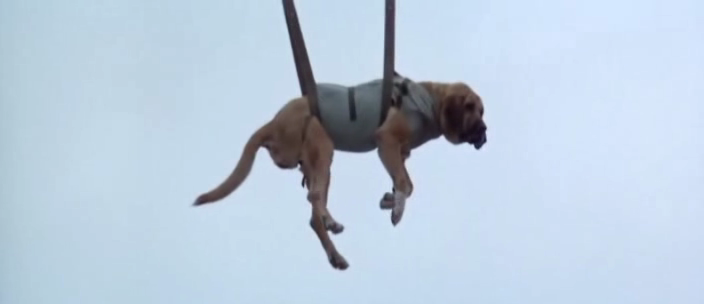
Clearly a big influence on seminal film, Operation: Dumbo Drop.
By “Opies,” Isley means the indigenous people in the area: “Original People.” “That’s what they call themselves now,” he says condescendingly. Isley says the Opies have a legend about Katahdin, a bigfoot-type creature “larger than a dragon, with the eyes of a cat.” However, Isley suspects the missing people are the doing of the Opies themselves, not some mythical creature. (He would, being firmly in the finely carpented pocket of Big Wood.) Speaking of the Opies, viewers meet them soon, as Isley’s attempt to drive Rob and Maggie to their cabin is barricaded by a wall of Opie protestors. Their leader, John Hawks (the very Italian-American Armand Assante) doesn’t care that Rob is with the E.P.A. He won’t let a truck from the lumber company enter the woods. After a tense standoff, they move out of the way, only to reveal a heavy chain has been stretched across the path between two trees.
Isley orders his employee Kelso (Everett Creach) to cut down the trees, and Kelso emerges from a truck, brandishing a chainsaw. “You cut my head off before you cut these trees,” John Hawks shouts, and lifts an axe. An epic chainsaw / axe battle follows, as the liberal Rob – long-held beliefs being tested – tries to defuse the situation. The chainsaw prevails and Kelso holds a chainsaw to the neck of the prone John Hawks. Ramona (Victoria Racimo), another Opie protestor, cuts the chain and lets the truck pass.
Isley brings Rob and Maggie to their water-access-only cabin. Rob opens the next day by fishing on his boat, and is soon astonished by the size of the salmon he sees in the river. Maggie is not surprised, noting that they are in the land of Paul Bunyan now (though I thought Paul Bunyan was more of a Michigan / Minnesota thing). She prepares the fish Rob caught for dinner and Rob settles comfortably into this newly domestic life. Not too comfortably, though, as he stiffens at Maggie’s mere mention of starting a family. Rob can’t fathom having a child in this chaotic world. Their marital tensions are soon interrupted by a scratching at the door. Rob goes to the cabin entrance and finds a raccoon convulsing on the front porch. Suddenly the raccoon bolts up his pant leg and begins to attack. The raccoon races into the cabin and starts to attack Maggie, as well. Thinking quickly, Rob grabs an oar and pins the rabid creature against the wall. Then he drives the raccoon straight into their roaring fire, like a boss.
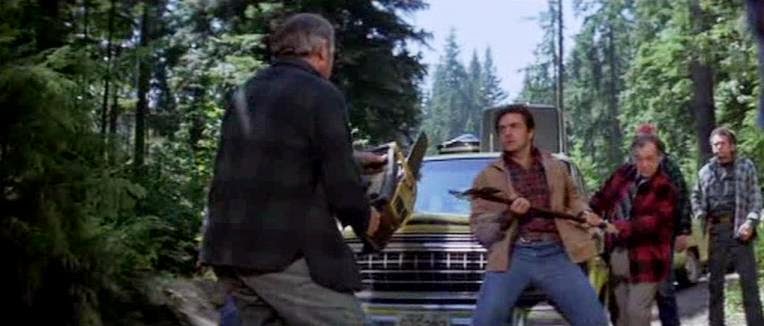
Looks like somebody brought an axe to a chainsaw fight.
The campers from the landing site continue their trek into the woods, but as campers go, they’re not happy. (It looks like they’re in the middle of a grim death march.) The only joy the teenage girl has is her belt radio, which blasts all your favourite hits of the ’70s. The father hears something in the woods – ”The bear loves disco,” Phil suggested – but they find nothing and continue on their hike. Rob calls Shusette back at home and tells him he’ll be sending home blood samples from the angry raccoon. He’s sure it wasn’t rabies, but the animal was definitely ill. John Hawks and Ramona then introduce themselves to Rob and tell him they need to speak privately. Rob refuses to join them, somewhat scared of the Opies. John becomes fairly irritated with Rob’s racism, complaining that he was educated in settler schools, but learning settler language was a total waste of time, because no white men ever listen to anything he says.
John Hawks says that his people are sick and dying. They don’t drink, but act as if they’re hammered. Ramona notes she’s seen many babies in their community born dead or deformed. “The end of this forest,” John insists, “is the end of my people.” Rob decides to take Maggie and follow John and Ramona to their village. Before they do, John shows them a traditional Opie settlement, complete with tipis, built by Ramona’s grandfather, Hector M’Rai (George Clutesi). Hawks wants Rob to see how they lived before the lumberjacks destroyed their home. “We were once a magical people,” Hawks says. (And the audience cringes.) While speaking of magic, Hector shows them what he says is a magical spot – an idyllic pond, only somewhat marred by the piles of cut lumber. Something bubbles, breaking the calm surface of the water, and Hawks retrieves it with his fishing net. Lying in the net: a tadpole the size of a large fish. And what’s upriver from this pond? The paper mill.
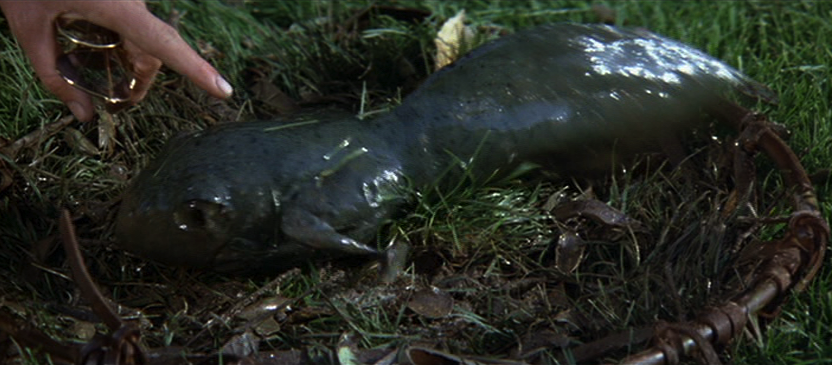
I’d say that’s more than a TAD-pole.
Rob and Maggie demand a tour of the paper mill from Mr. Isley. He shows them the pulp and paper process from top to bottom and the audience learns a whole lot about paper production. (Prophecy is mostly an educational film.) Rob is determined to find out what’s causing these bizarre problems in the animals. Chlorine is used to bleach the paper, but Isley swears it never leaves the mill. Rob interrogates him about the log transport, but Isley says a private company does the transport for them. Facing Rob’s righteous fury, Isley barks back, asking how many sheets of paper his report to the E.P.A. will use. “How many sheets of paper fill the filing cabinets in Washington?!” he shouts. Isley insists he’s just a business provider meeting a demand. Isley even suggests Rob test the water if he’s doubtful. Finding no obvious corporate malfeasance, Rob and Maggie leave the mill by boat, but Rob notices silvery stuff on his wife’s boot. “They gave us a trick question in medical school,” he says. “What’s the only liquid in the world that isn’t wet?” Mercury.
Mercury, heavier than water, might not appear in the water test. (I’m not sure if that’s scientifically sound.) Rob does some research on mercury poisoning while back at the cabin, orating his findings into a tape recorder. Mercury is used by the lumber company as a “de-sliming agent,” but inadvertently poisons the river’s fish. The Opies subsist on those fish. They seem drunk because the mercury has attacked their nervous system. The mercury would also explain the “rabid” raccoon’s behaviour. Maggie asks Rob what he’s found and instead of just telling her, Rob plays his recording. Mercury also affects fetal development (explaining the Opie infant mortality rates and deformities) – it’s the only mutagen that jumps the placental barrier. “Freakism!” Rob shouts. Maggie, horrified that she has eaten the tainted fish with a little zygote growing inside her, is crestfallen. Despite the many, many hints she drops, Rob never catches on to the fact his wife is pregnant and concerned about their unborn child.
Rob wonders aloud whether the legend of Katahdin is really just a mutant animal of some kind. Well, those valiant campers we met earlier are about to answer his question for him. They rest in sleeping bags at their campsite, the younger boy zipped up tight in a yellow, banana-like bag. The family is awakened by a rampaging mutant bear – part bear, part deli meat, and constantly bleeding – who tears into their camp. The banana boy attempts to hop away and the monster bear – in one of the most amazing horror movie kills in history – swats him, rocketing him into a large rock, where he explodes into feathers. (Seriously. Just watch it.)

Sure hope nothing happens to me while I’m tightly encased in my sleeping bag packed with feathers.
Rob and Maggie begin running blood tests of the Opie community. But before long, the 5-0 rolls in, hoping to arrest all the Opies they can. Isley, somehow leading the charge, says a family was found murdered at their campsite last night, and all the Opies are “guilty as hell.” All the evidence he requires is at the hospital, “in buckets.” The sheriff grabs John Hawks to arrest him, but Hawks resists, punching the cop in the face and running into the woods. Rob and Maggie ask Ramona to hire a helicopter to take them to where the campers were found. They fly to the remote area and land just as a nasty storm starts to brew. The helicopter pilot, Huntoon (Tom McFadden) warns Ramona and Rob they only have about ten minutes before he can’t fly out anymore due to the weather. Rob and Ramona find massive claw marks against the trees in the area, far too high for any normal bear. Maggie, however, stays with the pilot and pretends her morning sickness is actually just airsickness.
Rob and Ramona find John Hawks at the murder site, now sporting a quiver of arrows, and all three discuss what might have caused such destruction. The helicopter pilot makes small talk with the feeling-queasy Maggie and points out poacher nets in the creek. Maggie walks out into the increasingly intense storm and spots two hideous mutant bear cubs trapped in the net. (If she was feeling queasy before …) Rob, John Hawks, and Ramona rejoin Maggie and see the slimy cub-creatures. “We gotta’ get this one warm,” Rob says, freeing the one that’s writhing and moaning and clutching it to his chest. The mutant cub is evidence he can use against the paper company. John Hawks, feeling empty-handed, picks up the dead one and stuffs it into his jacket. They return to the helicopter, hoping to airlift their mutant beasts back to town, but the pilot says the storm has made it too dangerous. Rob insists they get the mutant cub somewhere safe, so Ramona suggests the traditional village her grandfather built. They can find shelter inside the tents!
When they arrive at Hector’s village, Ramona’s grandfather is nowhere to be found. But they enter one of the tents anyway and Rob begins to set up an emergency triage station. He instructs John Hawks to find reporters from the newspapers, employees from the paper mill – even the sheriff – and bring them to see the monster they’ve found. Hawks leaves, but refuses to have any business with the sheriff. Maggie begins to zone out, clearly envisioning the melted bear cub as some sort of parallel to the fetus growing inside her. Taking a break from cub care, Rob takes Maggie outside and says he thinks that Hector was correct: this Katahdin has awakened to protect the Opie community. The mutant bears will generate a media stir that could bring the paper company to justice. That’s when Maggie confesses she’s pregnant, and totally terrified because she’s eaten a mercury-laden fish. “Why didn’t I know?” Rob wonders. “You didn’t want to know,” Maggie says.
Ramona calls for Rob: the pulpy bear has started to stir. The police then arrive and John Hawks hides in the ancient system of tunnels that run under the village. Rob shows Isley the mutant bear cub and Isley is clearly digusted. Rob demands to know if Isley knew what the mercury was doing to the environment. “I didn’t want to,” he gasps, paralleling Maggie’s earlier comments. A bear-like shape moves through the forest toward the village and everyone panics, but it’s only grandpa Hector, cloaked in a bearskin. However, the real demon bear makes a grand entrance seconds later. Katahdin smashes its way into camp, swatting people and knocking over gasoline cans, causing fires as far as the eye can see. The bear partially mauls the helicopter pilot, but Hector, standing like a sentry, remains unharmed by the monster. (Maybe Katahdin thinks he’s a bear, too.) Rob grabs the injured pilot and all the survivors of the bear attack hide in the tunnels. They hide in silence, their tense eyeballs shifting back and forth in the dark, as screams of horror emanate from aboveground. Maggie holds the mutant cub to her chest. Once things fall silent, the sheriff climbs the ladder out of the tunnels to see the coast is clear. If the bloody corpse that drops down seconds later is any sign, the coast is definitely not clear.
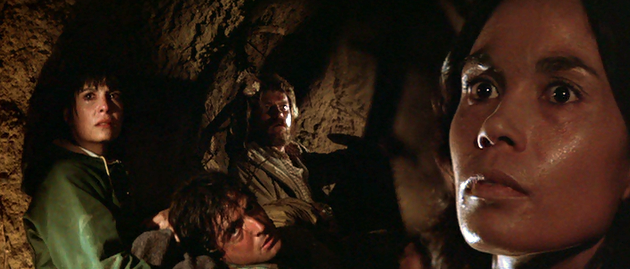
Journey to the Centre of the Earth: Bear Edition.
Eventually, the coast does become clear, and the survivors try to figure out what course of action to take. They want to get the mutant cub to safety, but they also have to find medical assistance for the pilot. And though the helicopter has a radio, it apparently only works when the chopper is in the air. (Again, not sure about that science.) Isley offers to go on his lonesome to a nearby telecommunications tower to radio for help. The others fashion a makeshift stretcher and try to carry the pilot back to the Opie Village. (Shades of both Rituals and The Revenant.)
The Opie village is mostly empty, the villagers mysteriously gone, but John Hawks, bow-and-arrow in hand, goes scouting and finds an armoured truck abandoned up the road. Into the truck piles John, Rob, Maggie, Ramona, grandpa Hector, and the injured pilot, lying in the back.They make a treacherous escape, driving the truck over rocky pathways in the dead of night. Rob trains his high-powered flashlight on the trees ahead when suddenly, who should appear but Katahdin! The bear sends the truck toppling over. In the panic, the mutant cub attacks Maggie, biting her throat. The gang escapes from the truck, all except for the injured Huntoon, pinned by the overturned vehicle. Hawks tries to free him, but Katahdin arrives and bites the pilot’s head clean off.
The remaining survivors run into the river, the cub still biting and tearing at Maggie’s throat. (Why is she still carrying that cub?!) Rob pulls the little ground-beef cub from his wife and drowns it in the water. Grandpa Hector, however, doesn’t join the rest of the crew in their swim across the river. Instead he stands at the shore, welcoming Katahdin. As the others swim away, they see Hector being tossed around by the bear like a rag doll.
Our heroes make it to the far shore, beaching themselves on the dock outside Rob and Maggie’s cabin. Unfortunately, Katahdin is still slowly pursuing them, walking deeper and deeper into the water like some mutant-bear Viriginia Woolf. Our heroes do nothing but recuperate on the dock. Once the bear completely falls below the water line, Rob cheers, “It’s drowned!” (Clearly, his studies never told him about how well bears can swim.) They wait forever on the dock and – surprising no one but them – Katahdin emerges out of the water yards from where they’re resting. (What did they expect?) The four survivors hurry into the cabin and begin to bar the doors and windows with furniture.
Rob finds a rifle. (“No silver bullets,” quipped Phil.) The towering bear smashes its way into the cabin through the roof. Rob falls on his back and shoots. Katahdin retreats, but then blasts through the front wall. A chunk of wood flies forward, knocking Ramona over (perhaps killing her). John Hawks fires a few arrows into the bear, but Katahdin bats him away, killing our Opie hero instantly. Rob picks up the bow and arrow and attempts to figure out how to use it, but Katahdin picks him up in its massive paws. Rob takes the arrow and stabs the bear’s eyes over and over repeatedly. Blood spurts profusely and, eventually, Katahdin falls backward into the water, dead.
Rob, however, isn’t content to leave it at that. He takes a flying leap off the dock, arrow held above his head like a sword. He stabs the animal several more times (though it’s very dead). In the post-climactic scene, we see Rob and the totally-okay-and-convalescing Maggie, safe and sound in a plane flying over the Androscoggin River. No need to worry, the white characters of the movie have survived unscathed. Suddenly, a mutant bear head pops up in front of the camera, the Prophecy‘s version of Carrie’s hand shooting out of her grave.
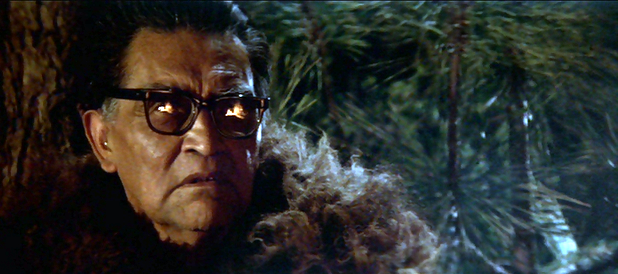
“I’ve seen fire and I’ve seen rain.” – Grandpa Hector
Takeaway points:
- Prophecy is quite explicitly an eco-horror film. That is, it’s a film where human disregard for the natural environment causes the horror, causes the dangers that threaten human life. The use of mercury at the paper mill causes illness and mutation, and one of those mutations – the mutant Katahdin – seems to be exacting the natural world’s revenge on the human population. The film’s writer, David Seltzer, based the story on an IRL environmental disaster in the Japanese city of Minamata. In 1958, researchers discovered mercury waste from a chemical plant was being dumped into a nearby river, causing loss of vision and muscular control, and even insanity in the local population. What’s interesting about this eco-horror story is that this environmental disaster is not just the doing of an evil corporation. We’re implicated. When Isley reminds Rob Verne how much paper he uses, that he’s merely meeting the demand for his product, he reminds audiences that when you point a finger, four more fingers are pointing back at you. Our way of life is unsustainable without the creation of these Katahdin-like monsters. And we’re only able to live in our culture because we remain willfully ignorant of the toll modern industrial production has on the earth. As both Isley and Rob say, we don’t want to know. (Personally, I see this as a bit of a rationalization on Isley’s part, but I’m not sure the filmmakers see it the same way.)
- Much moreso than many horror films, Prophecy’s depiction of indigenous culture is problematic, at best. For one, the lead indigenous role is played by the Italian-American Armand Assante, who wasn’t even really a marquee name by this point. Furthermore, a whole uncomfortable “magical native” vibe runs through the script. John Hawks even explicitly says at one point, “we were once a magical people.” The film sort of turns indigenous people into mythical creatures not unlike Katahdin itself. It also doesn’t give them a name. The Opies in Prophecy are not any particular tribe or people. The geographic setting of the movie might suggest they are Abenaki, but this would involve the filmmakers actually researching about the local indigenous people of Maine. Something they were clearly not interested in, given that the Opies dwell in tipis, though tipis were used nearly nowhere outside the North American plains. (Even the word “Opies” just made me uncomfortable. It’s like the filmmakers invented a new racial slur.) Note also that every single indigenous character dies at the hands of the mutant bear, while our white leads make it home safely. Even though this Katahdin was supposed to be some sort of protector to the Opie culture.
- The film does a weird job in portraying Rob as a liberal do-gooder interested in social justice. He does display a righteous single-mindedness which is sometimes indicative of the males of the species, but what’s strange is how little he seems to care about the problems faced by indigenous groups in the area. In the city, he focuses on improving the lot of the inner-city black community, but doubts the reasons for the Opies’ protests. He scoffs at their plight, noting that people living in tenement housing would kill to live in such wide open wilderness. Really, Rob?
- Obviously, one feels compelled to compare Prophecy to another movie with a bear-mauling centrepiece: Oscar darling The Revenant. Is The Revenant a better film than Prophecy? Probably. Does Leonardo Dicaprio explode against a rock when the bear swats at him. No. There are pros and cons to both films.
- Prophecy is allegedly one of master of horror Stephen King‘s favourite movies. I think this can be entirely attributed to the fact that it takes place in his beloved Maine.
- Film critic Leonard Maltin famously referred to the mutant as “a giant salami,” which is pretty accurate.
Truly terrifying or truly terrible?: Though Prophecy is pretty terrible – this is far from Frankenheimer’s best work – it’s also terribly entertaining. I was willing to watch Prophecy for the exploding boy in the sleeping bag alone. No one even told me there’d be a raccoon attack and a chainsaw-axe battle in store! You might have nightmares about the seriously twitchy, goopy-looking mutant bear and cubs, but that’s the only real source of terror in Prophecy.
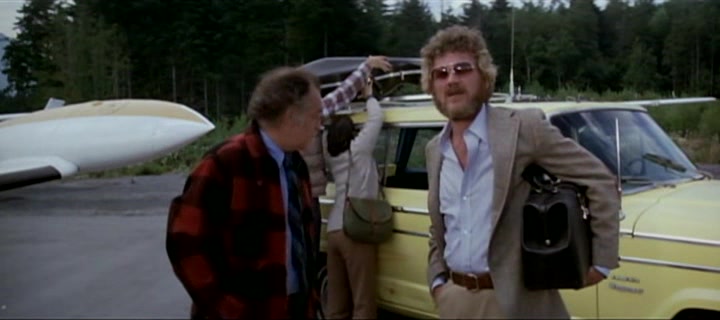
You don’t think this is an appropriate camping outfit? Should I do up my buttons?
Best outfit: Despite being filmed in the late 1970s, Prophecy doesn’t display any of the fashion excesses of the era. The clothing is fairly reserved. But I do admire the audacity with which Rob Verne dresses for what is – for all intents and purposes – a camping trip: tinted sunglasses, open shirt, tan blazer.
Best line: “I’m strictly a rat-bite and gas-leak man.” – Rob Verne, noting his unsuitability for an E.P.A. job (or outlining a pretty decent OKCupid profile)
Best kill: Easiest choice in history: the kid in the yellow sleeping bag just explodes when Katahdin sends him flying into a giant rock. Explodes. here’s no topping it.
Unexpected cameo: Richard Dysart, who plays Isley, played Leland Mackenzie on several seasons of L.A. Law. And the actress who plays Maggie’s cellist friend has the intriguing name Evans Evans. Better yet, the actor inside the mutant bear suit, Kevin Peter Hall, also portrayed the Predator in the first two Predator films, as well as Harry from Harry and the Hendersons. The guy was 6’9″! Tragically, he died at age 35 due to complications from AIDS.
Unexpected lesson(s) learned: There are many lessons to learn in Prophecy. I am basically qualified to run a paper mill and diagnose methyl mercury poisoning after watching it, so exhaustive is the exposition. But the most important lesson: if you find yourself in the middle of a bear attack, go for its eyes.
Most suitable band name derived from the movie: De-Sliming Agent
Next up: Halloween III: Season of the Witch (1982).
